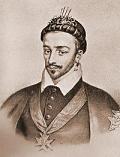
 | The German Huguenot Museum in Bad Karlshafen |
 |
History - 5. Bartholomew's Day1. How the Huguenots got their name The first pogrom in modern times Bartholomew's Day Copper engraving: Jan Luyken It was in France of all places, a country economically and culturally to the fore in Europe, that the first pogrom in modern times took place. In the morning of 24th August 1572 the bells of the Paris church Saint-Germain l'Auxerrois called the citizens to participate in a blood bath. Around 2000 Huguenots were brutally murdered in their houses and in the streets of the capital. In the following weeks about 10.000 more were murdered in other French towns. The perpetrators were the soldiers of Duke Henry I of Guise (1550-1588), known as "le balafré" (scarface), Parisian troops and the discontented Catholic proletariat. It was disagreement on foreign policy that led to the massacre. The Edict St GermainIn August 1570 the Edict of St German ended the third War of Religion. The marriage of the Protestant leader Henry of Navarra (1553-1610) to Marguerite of Valon (1553-1615), the daughter of Catherine of Medici (1519-1589) was intended to bring peace to the two rival parties. Many Huguenot nobles came to Paris to attend the royal wedding. Abortive attempt on the life of the Huguenot leader Gaspard de Coligny Admiral Gaspard de Coligny, the leader of the Huguenots, had won the foncidence of the weak young King Charles IX (1150-1574). For the Catholics Coligny had become too powerful. When it looked as if he had persuaded the King to send an auxiliary force to the Netherlands to support the Dutch rebels in their struggle against the Catholic Philip II of Spain, the Catholics hired an assassin to kill the Admiral. But the shots fired on August 22nd 1572 only injured Coligny. Religious tension in the capital was now at boiling point. Fearing a Huguenot reprisal, the royal council decided to murder the Huguenot leaders in a preemptive strike in the early hours of August 24th 1572. The massacre begins Coligny's head is brought to Catherine of Medici The troops led by Henry, Duke of Guise, first murdered Coligny in his house in the Rue de Rivoli. He was beheaded and flung onto the street. The sound of the bells of St Germain l'Auxerrois then sparked off an explosion of popular violence. 2000 Protestants were brutally murdered. Henry of Navarra and Henry of Cordé (1552-1588), both princes of the blood, were spared. Those responsible either swagger or keep silent about the massacreOn 26th August 1572 Charles IX claimed responsibility for the murders. The real perpetrators were Catholic Spain, the Duke of Guise (1150-1588) and the Catholic Church which silently approved. Pope Gregory VIII (1502-1585) even had a victory medal struck in Rome. It bore the inscription (Ugonottorum Strages 1572). He also comissioned a fresco consisting of three parts from the Renaissance painter Giorgio Vasari (1511-1574) which can still be seen today in the Sala Regia. These images of horror celebrate the triumph of the so-called just cause. Massacres followed in other towns in Orléans, Meaux, Bourges, Albi and Rouen in SEptember, in Toulouse, Gaillac and Bordeaux in October. For this reason the Frensch historian Jules Michelet rightly points out, that the St Bartholomew massacre was not a day, but a season. Political effects of the massacre Henry III The political effects were to the detriment of the perpetrators. The whole of Europe was horrified by such brutality. The Protestant countries were readier than ever to send troops and material to the aid of the Huguenots. Just four years later Henry III, the successor of Charles IX, was forced to officially express his disapproval of the events in Paris, while the Huguenots now grasped how vulnerable they were, and set about improving their organisation to be better prepared for a further outbreak of violence. Henry of Navarra, who had been brought up in the Reformed faith, was their leader. When Henry III was assassinated in 1589 Henry of Navarra was next in the line to the throne. Only his religion stood in his way. Thinking that Paris was worth a mass he adjured his Protestant faith and converted to Catholicism. With the Edict of Nantes (1598) he granted his former fellow Protestants freedom of Conscience and limited toleration. |
© The German Huguenot Museum 2025 |